|
|
|
|
|
|
THE RELATIONSHIP BETWEEN HERMITS and COMMUNITIES in the WEST, WITH SPECIAL REFERENCE to the TWELFTH CENTURY
Sister Benedicta Ward, SLG
Solitude and Communion, Papers on the Hermit Life given at St. David's Wales, by Orthodox, Roman, and Anglican Contributers. ed. A.M. Allchin, Fairacres Publ. no. 66, (SLG Press, Oxford, 1977), pp. 54-63
(1)
RB & Hermits;
(2)
Crisis of Cenobitism [Wulfric, Christina, Godric];
(3)
Grandmont;
(4)
New Orders;
(5)
Strict
Ascetics; (6)
Conclusions
IN the second half of the eleventh century, Peter Damian, the Prior of Fonte Avellana, wrote about a problem recently raised in his community: ‘Many of the brethren, followers of the eremitic life, have asked me whether, since they live alone in their cells, it is right for them to say Dominus vobiscum, Jube, domne, benedicere, [the Lord be with you; grant, Lord, a blessing] and the like, despite the fact that they are alone.’ He goes on to answer the question himself with a long letter on the hermit life which is known as ‘The Book of the Lord Be With You’ 1 in which he included the following passage as the kernel of his argument:
He [the hermit] sees as present with the eyes of the spirit all those for whom he prays ... he knows that all who are praying with him are present in spritual communion. . . Therefore let no brother who lives alone in a cell be afraid to utter words which are common to the whole Church, for although he is separated by space from the congregation of the faithful, yet he is bound together with them all by love in the unity of the faith; although they are absent in the flesh, they are near at hand in the mystical unity of the Church. 2
In examining the exact ways in which hermits were connected with communities in external matters, it is essential to have in mind that these external links are meant to subserve and express that deep inner unity in which the hermit is ‘bound together with them all by love in the unity of the faith’. When a monk goes to live apart from his brothers it is possible to note and mark the ways in which he is separate from them, but what cannot be assessed in terms of legislation is the main part of his life which is concerned with affirming his unity in Christ with them all; in the mysterious words of St Antony, the father of hermits, ‘my life is with my neighbour’.
On the level of external contact between hermits and society, however, this fundamental spiritual link has been expressed in different ways in different ages. I would like to examine here the tradition within monasticism in the West in the Middle Ages, with special reference to some developments in the twelfth century. The material is taken mostly from the lives of saints but I have also tried to show how the relationship between hermits and society was viewed in theory as well as in practice.
|
[1] EARLY HERMITS and the RULE of BENEDICT |
THE Rule of Saint Benedict was the basis of Christian monasticism from the eighth century to the eleventh. It is often supposed that this Rule formally excluded the idea of the hermit life, and a superficial reading of the text in itself supports this claim. However, no Rule can be assessed truly simply by its written words, and there is ample evidence that hermits continued to exist within the Benedictine tradition and to find their justification within the Rule itself. Cassiodorus, like Jerome and Cassian, had seen the hermit life as a stage within the monastic life, and at Vivarium he provided hermitages for this purpose; 3 it appeared to the early Benedictines that this was the teaching also of the Rule of Saint Benedict. In the first chapter of the Rule, four kinds of monks are discussed, and though the Rule provides most of all for the ‘strong race of cenobites’ 4 the hermits are described as the end-product of the cenobitic life:
After long probation in the monastery, having learnt in association with many brethren how to fight against the devil, [they] go out well-armed from the ranks of the community to the solitary combat of the desert. They are now able to live without the help of others, and by their own strength and God’s assistance to fight against the temptations of mind and body. 5
The monastery is ‘a school of the Lord’s service’ 6 in which men attain ‘some degree of virtue and the rudiments of monastic observance’;7 but the Rule claims only to be ‘a little Rule for beginners’. 8 For those who ‘hasten to the perfection of the monastic life’, St Benedict recommends ‘the teaching of the holy Fathers ... the Conferences of Cassian, and his Institutes, and the Lives of the Fathers and also the Rule of our holy father, Basil’. 9 St Benedict himself lived as a hermit, and it is probable that at Monte Cassino there were, as at Vivarium, separate cells for hermits. In the following centuries it is clear that there were hermits attached to monastic houses as a matter of course and, though the perils of such a life and its rarity were increasingly recognized, there is constant evidence of its existence. Grimlaicus, in his Rule for solitaries in the ninth century says, ‘to enter the solitary life is the highest perfection; to live imperfectly in solitude is to incur the greatest damnation’. 10 Archeological discoveries have given evidence of hermitages around monasteries, and particularly near Cluny, which was as much a centre for hermit life as for liturgical devotion. 11
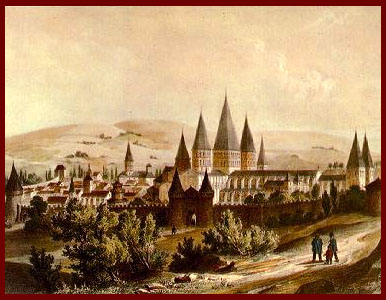 |
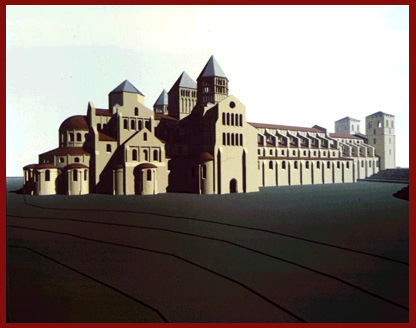 |
| Cluny, 18th cent. painting | Medieval Cluny (computer reconstr.) |
Many chroniclers describe hermits, and the fact of their existence is apparent from many saints’ lives. Conciliar decrees and monastic customaries tried to exercise some control over the entry of monks into such a life and over their subsequent activities. These hermits had been monks and, after living in a monastery for some time they went, with the blessing of their abbot, to live alone or with one or two companions. Their lives are described in terms familiar from the fourth century and the beginnings of monasticism; solitude, prayer, ascetic practices, and simplicity of life were their characteristics. In the reasons for their choice of such a life and in the paths that led them there they differed widely. There was, for instance, Wulsi of Evesham, a layman who was professed at Crowland in the eleventh century, and who found himself unable to participate in the liturgical and administrative life of a large community; he became a hermit in a cave near Evesham. On the other hand, Maurus, a former abbot of Fulda, chose to enter the eremitical life because he would have leisure there for study. 12 There were monks trained in the East who settled as hermits in the midst of the Western cenobitic communities, like Symeon of Trier and Constantine of Malmesbury, and both were accepted and praised. There were hermits who received the blessing of their abbot to embrace a life of solitude permanently; there were also part-time hermits. Notably, there were bishops and abbots, busy administrators, who had cells to which they could retire. Hermedland, first Abbot of Aindre, always spent Lent in solitude and at the end of his life retired permanently to a hermitage. 13
There was a peaceful relationship of concord between these hermits and their communities. At times a hermit might be recalled because of the needs of his house, most of all if he were needed as abbot for a time. Monks would visit their hermits and consult them on spiritual matters, and some of the hermits found it proper to their vocation to return to the monastery for the liturgy on Sundays and feast days. Hermits were relatively few, and it was because the numbers remained small that this peaceful co-existence was possible. Customaries sometimes legislated for a percentage of hermits only, out of a community at any time, and this was never more than ten per cent. In all this the tradition both of the West and of the East does not seem to diverge: the hermit was a monk who sought solitude for a longer or shorter time, who maintained links with the monastery in certain ways, and who was allowed for the rest to follow out his vocation as an individual however God called him. It is with the twelfth century that there is a change, and this is closely connected with what is often called the ‘crisis of coenobitism’ in the West.
|
[2] THE CRISIS of COENOBITISM |
IT is clear that in the twelfth century a new type of hermit emerged. The traditional pattern of a monk who entered on the hermit life after training in the monastery was still recognized on the same terms as before, but there were many also who had either never been monks or who had found the monastic life in some way unacceptable. With these new hermits a distinction was made between monks and hermits along sharper and less amicable lines. The problems involved were complex and to some extent meant that the term hermit and also the term monk were being re-defined. Since the influence of this is still with us, especially in our concepts of contemplative communities, a closer look at this movement is essential.
There were, first, those who began the hermit life without monastic training. Then there were those who had been monks but had undertaken a hermit way of life more or less as a clearing ground until a concept of community again emerged for them. In the first group there were three famous English hermits: Wulfric of Haslebury, Christina of Markyate, and Godric of Finchale. All of them began their hermit lives outside the monastic structures, though all of them developed close relationships with communities later.
|
|
|
Wulfric |
|
|
WULFRIC 14 was born of a middle-class English family in the reign of William Rufus at Compton Martin in Somerset. He was ordained below the canonical age and lived as a careless and worldly cleric at Deverill near Warminster where he neglected his duties for hunting. In about 1125 he underwent a conversion, and was also offered the cure of the village where he had been born. There, under the protection of William Fitzwalter, he became an anchorite in a cell in the wall of the church where he lived until his death. The villagers supported him, and turned to him for spiritual advice, and possibly for practical help since it seems at least possible to deduce from his life that his cell was used as a kind of strong room in which villagers could safely leave their money in the troubled times of King Stephen. Wulfric was known to St Bernard by repute and was approved by him. He was consulted by kings and lords as well as local people, and he had some connection with both the local Cluniac priory of Montacute and the Cistercian house at Ford. The monks of Montecute tried to claim his body after his death, but he was in fact buried in his cell. John, a monk of Ford, wrote his life with admiration and affection.
|
|
|
Christina of Markyate |
|
|
LIKE Wulfric, Christina of Markyate 15 did not enter a novitiate in a religious house. This may well have been because she had literally no chance to do so. The opposition of her parents, lack of a dowry, and the prohibition of her doing so by the bishop, debarred her from any monastic house whatever. In order to fulfil her desire for a life of consecrated virginity, she ran away from home and lived among a close net-work of hermits who inhabited the district around St Albans. She joined at first a woman recluse, Alfwen, a hermitess at Flamstead; after two years she went to live with the hermit Roger at Markyate. Roger was one of a remarkable group of hermits who lived near the Abbey of St Albans, and from them Christina received her training as a hermit. After Roger’s death she continued, after a year elsewhere, at Markyate and soon made contact with Geoffrey, the Abbot of St Albans. Roger had been a monk of St Albans, and Christina’s connections with the monastery were close; it seems almost certain that the St Albans’ psalter was written at St Albans for her use. Her friendship with Abbot Geoffrey was deep and continuous, and she was regarded by the other monks as a spiritual guide. It is, however, notable that she did not make her profession as a nun until 1131, after living for many years as a hermit and after being offered the abbatial office at St Clements, York. Her profession, moreover, was made in the monastery at St Albans. Women joined her at Markyate, and though the account of her life breaks off before the death of Geoffrey, it is clear that she continued as a recognized and able abbess for the rest of her life.
|
|
|
Godric of Finchale |
|
|
GODRIC of Finchale (c.1065-1170) 16 was an English merchant and sailor who was converted to a more serious Christianity in Jerusalem. He visited Rome, Compostella and Jerusalem, and finally returned to his native Northumbria, where he simply went and lived in solitude. Some land at Finchale was leased to him by the Bishop of Durham, and he also made contact on a spiritual level with the Durham monks. After some years he decided to place himself under obedience to the Prior of Durham, and a more definite relationship with the community emerged. The Prior sent a monk to say mass at the hermitage every feast day, and Reginald, Godric’s biographer, a monk of Durham, visited him at those times and also was with him when he became ill at the end of his life. A priory of Durham was established eventually at Finchale.
|
[3] THE ORDER of GRANDMONT |
THESE hermits were part of a new eremitic pattern, and a more famous one of the same kind shows how this solitude could emerge into a newform of community. Stephen of Muret (1045-1144) 17 learned about monastic life while visiting the monks of Calabria, but he did not become a monk in any formal sense. Instead, he went alone to a mountain near Muret and there professed himself. His biographer says:
He had a ring with which he espoused himself to Christ, saying: ‘I, Stephen, renounce the devil and all his pomps, and devote myself to God, Father, Son and Holy Spirit, God Three and One, Living and True’. He also wrote out this formula and placed it on his head saying: ‘I, Stephen, promise to serve God in this desert in the Catholic faith, and for this cause I place this form upon my head and this ring on my finger that at the day of my death it may be unto me according to my promise. . . . I ask you, Lord, to restore to me the wedding garment and count me among the sons of the Church at the wedding feast of your Son.’ 18
Other solitaries joined Stephen and the Order of Grandmont was formed. The Grandmontines kept the eremitic life as their basic aim; all the administration was in the hands of the conversi, and a standard of evangelical poverty was maintained which foreshadowed that of the Franciscans later. They claimed to follow only the Gospel and not even the Fathers. Their solitude, however, was like that which evolved for other hermits, a corporate solitude, in which each member of the group lived in varying degrees of personal solitude; but the characteristic feature of them as a group was that they were apart from society.
These four did not pass through any formal novitiate nor was their link with the older monastic communities that of formal training and profession. The hermit life was not for them the final stage of a monastic vocation in which they were living out their monastic life under different conditions but basically still as an integral part of their community. They are typical of the new understanding of hermit life in the twelfth century. Stephen of Grandmont provides a link between this kind of new hermit and the more famous kind who were hermit-founders.
|
[4] THE NEW EREMETICAL ORDERS |
THE new monastic Orders of Camaldoli, Chartreuse, Savigny, Fontrevault, and above all, Cîteaux, were the end product of the hermit explosion of the early years of the twelfth century. Besides these, over fifty other communities which adopted a communal rule of life began from hermit foundations. For instance, there was a group of hermits at Llanthony early in the twelfth century, and by 1120 they had become a house of canons following the Rule of St Augustine with customs from Aidgate, Colchester and Merton. 19 Besides these, many houses of hermits became affiliated to Cîteaux, including Morimond and Pontigny.
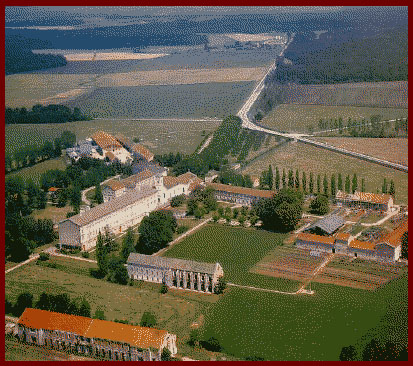 |
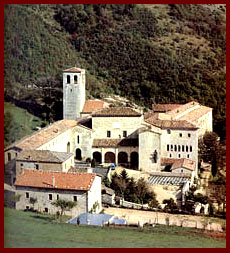 |
| Citeaux | Fonte Avellana |
The founders of these communities lived at first as hermits. Romuald, the founder, with Ludolph and Julian, of Fonte Avellana, tried first of all to persuade his community at St Appolinaris in Classe to adopt his ideas, then left it to live alone until a new community formed around him. 20 John Gualbert lived as a hermit at Vallombrosa, and the monastery that grew there continued to be known as the Hermitage, both because of its austerity and its remoteness from the world. Stephen of Obazine, Bruno of Cologne, and Vitalis of Savigny all contemplated a form of solitude which was not that of existing communities.
Two things distinguished their idea of hermit life from that of the more traditional hermits:
[1] first, their concept of corporate solitude; and
[2] secondly, their desire for stability and obedience to recognized authority among themselves.
The idea of solitude in a group is different from the idea of personal solitude. St Norbert said, like any hermit in any age, ‘I do not want to stay in the towns; I prefer places that are deserted and uncultivated’. 21 But he did not expect to stay in the desert alone. Vitalis of Savigny withdrew to the ‘desert’, but it was in company with other recluses.22 The desire for obedience was a corporate ideal, and when combined with the new concept of solitude as being simply away from the towns, led to the evolution of hermits into communities.
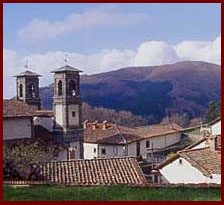 |
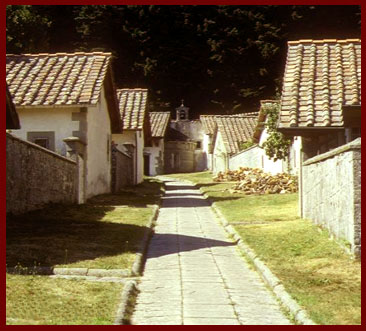 |
| Camaldoli | Camaldoli, hermitages |
Of the new communities, Camaldoli, Chartreuse, Fonte Avellana, and Grandmont came closest to the Eastern concept of a lavra, though with more monks than was usual in the East. The brothers lived in separate cells and the degree of communal life was minimal. At Fonte Avellana, for instance, they met only on Sundays for Mass and Office, while at the Grande Chartreuse [cf. St. Bruno of Cologne, 1030-1101] they only sang the Office of Vigils together.
At Grandmont the separation of the group as a whole from the rest of the world included a stress upon absolute individual solitude as well. The monks in these groups were called hermits. It was not envisaged that they would move on to a greater personal solitude; it was a corporate life in which it was held that the hermit ideal was already realised. It is possible to see this kind of group as a restoration, almost certainly an unconscious restoration, of the idea of the skete which had fallen out of use in the West, the difference being that whereas the Eastern skete was a stage towards the complete hermit life, the hermits of Camaldoli and Chartreuse were basically committed to their monastery.
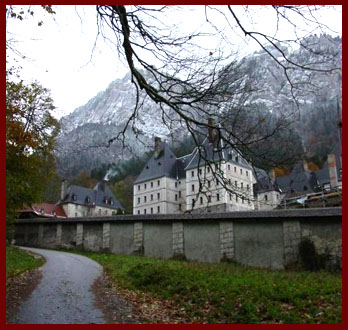 |
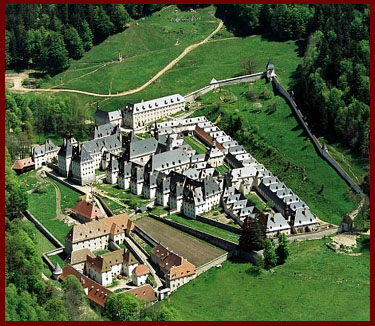 |
| GrandeChartreuse | GrandeChartreuse |
The most famous of these new communities was, of course, Cîteaux, and the differences between the old and new forms of monastic life received dramatic publicity as a conflict between the Cluniacs and Cistercians. The Cistercians were, more than any of the new Orders, concerned to integrate solitude into community. They began as a group of hermits, and called their new home a ‘desert’; hermits individually and in groups were to join them later. But the Cistercian way of life was basically inimical to the concept of individual solitude. The Order of Cîteaux claimed to have found the ‘more perfect way’ of St Benedict’s Rule and to have embodied it in their corporate life. This idea of integrated solitude could cause difficulty when members joined who discovered a desire in themselves for the traditional hermit withdrawal; it was seen as a reproach, as opting out of what all wanted and had, and in this it is possible to see the problems that later faced contemplative communities whose members sought greater solitude from a context which de facto claimed to have it already.
|
[5] HERMITS AS STRICT ASCETICS |
THE hermits formed communities, and with this they posed a new question about the meaning of the term ‘hermit’. The topic gave ample scope to the twelfth century’s attrait for categorization, but in discussions of the matter the hermit escaped too rigid definition in a significant way. The Libellus de Ordinibus Diversis, for instance, lays the stress in differentiating between monk and hermit on the life itself: ‘I do not argue much about the name when I see the works performed ... without the life the name alone is empty’. 23 The term hermit is in this treatise extended to include the new hermit communities. The monk, the writer says, is a hermit when he goes into the desert with like-minded men: ‘He will penetrate the innermost part of the desert with Antony where he will merit the aid of the angels against the demons and the company of good men following him for God’s sake; when you have done well you must go out into the mountain with Jesus and pass the night there in prayer.’ It seems that by the end of the twelfth century the hermit was beginning to be defined as ‘ascetic’ rather than as one who lives alone. The most extreme example I know of this re-definition is in the accounts of the martyrdom of Archbishop Thomas Becket at Canterbury. When the monks stripped the dead body of this man who had not in life been notable for solitude, either corporate or personal, they discovered that he had worn a hair shirt. ‘Lo,’ they exclaimed, ‘here indeed was a true monk and hermit.’ 24
|
[6] CONCLUSIONS |
THE evidence of the hermit movements in the West in the twelfth century points to several conclusions.
First, there is the overall tendency to understand the hermit life as no longer exclusively the summit of monastic life in community. Two aspects of this appear and lead in different directions, both of which have their bearing on contemporary approaches to eremitism in the Church.
[1] There were, first of all, those who saw the hermit life as a preliminary to life in community, and from these there emerges a new understanding of the relationship between community and solitary in which the stress is placed upon the solitude of the group rather than the individual. It is from these groups who tried to embody the ideals of solitude within communities that the modern ‘contemplative’ communities derive in at least certain aspects; and the problems posed for these communities with regard to the individual hermit remain.
[2] Secondly, however, hermits were known in the twelfth century who had never undergone any religious training in a community and whose relationship with the monks was not necessarily of a formal nature. This underlines the essentially free and unstructured nature of the hermit vocation and serves to emphasise the fact that there will always be in the Church those whom God calls into the wilderness and keeps there for their love of the Crucified to overflow in ways of prayer. That is the service Peter Damian speaks of in the quotation with which this paper began. It is then for the monks and for the Church to enable them to remain hidden within the quiver of his love.
1 1. Peter Damian, ‘The Book of the Lord Be With You’, trans. Patricia McNulty in Peter Damian, Selected Writings, Faber 1959, pp. 53-4.
2 Ibid., pp. 73-4.
3 Cassiodorus, Institutiones, ed. R.A.B. Mynors, Oxford 1937, p. 74.
4 The Rule of St Benedict, ed. and trans. J. McCann, London 1952, p. 16.
5 Ibid., cap. 1, p. 14.
6 Ibid., Prologue, ^. 12.
7 Ibid., cap. 73, p. 160.
8 Ibid., cap. 73, P. 162.
9 Ibid., cap. 73, p.160.
10 Grimlaicus, Regula Solitarium, cap. 23, PL CIII, col. 604.
11 I am greatly indebted for information about Cluny and about the hermit movements as a whole to an unpublished thesis by Henrietta Leyser, ‘The New Eremitical Movements in Western Europe, 1000-1150’ (Oxford, 1966).
12 Rudolph, Miracula sanctorum in Fuldenses ecclesias translatorum, Monumenta Germaniae Historica, Scriptures, XV, i, ^. 340.
13 Vita S. Hermelandi abb. Antrens, Acta Sanctorum Ordinis S. Benedicti, ed. Mabillon, 3, 1, p. 396.
14 John of Ford, Life of Wulfric of Haslebury, ed. Dom Maurice Bell, Somerset Record Society, vol. 48, 1933.
15 Christina of Markyate, ed. and trans. C. Talbot, Oxford 1959.
16 Reginald of Durham, Libellus de vita et miraculis S. Godrici, ed. J. Stevenson, Surtees Society 20 (1845).
17 Vita S. Stephani confessoris (Muretensis) PL 204, cols. 1013 ff.
18 Ibid., col. 1016.
19 J. Dickinson, The Origins of the Austin Canons, SPCK 1950, pp. 111-12.
20 Peter Damian, Vita Romualdi, PL 145, col. 336.
21 Herman, Liber III de miraculis S. Mariae Laudenensis, cap. 3, Monumenta Germanise Historica, Scriptores, 12, p.656.
22 Ordericus Vitalis, Historia Ecclesiastica, Bk. 8, cap. 27, ed. A. le Prévost and L. Delisle, Paris, (1838-1855), p.449.
23 Libellus de Ordinibus Diversis, ed. Constable and Smith, Oxford 1972, p.26.
24 Materials for the History of Archbishop Thomas Becket, ed. J.C. Robertson (Rolls Series, 1875-1833) vol. 1, 12.
This Webpage was created for a workshop held at Saint Andrew's Abbey, Valyermo, California in 2003